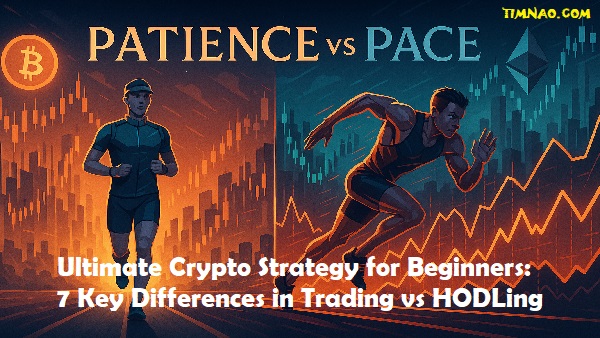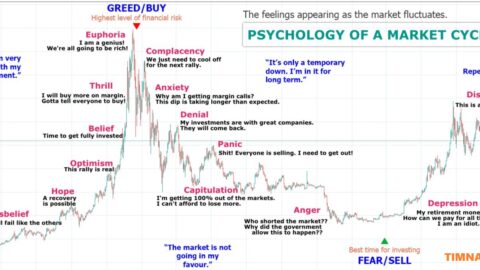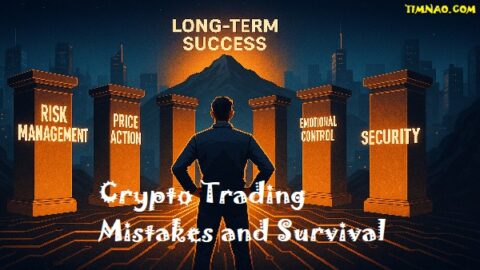The Ultimate Crypto Showdown: An Unbeatable Guide to Trading vs HODLing for Astute Beginners! 🚀
Welcome to the world of cryptocurrency, a universe buzzing with potential, innovation, and life-changing opportunities. If you’re new here, you’ve likely heard the terms “trading” and “HODLing” thrown around. These are not just slang; they represent two fundamental approaches to navigating the crypto market. Choosing the right crypto strategy for beginners is a critical first step on your investment journey. It’s the compass that will guide your decisions, manage your expectations, and ultimately shape your success in this dynamic landscape.
This guide is designed to be your trusted companion, breaking down the core principles of trading vs HODLing. We’ll move beyond the jargon and dive deep into what each strategy entails, who it’s best suited for, and how you can get started. Forget the dense, textbook-style explanations. We’re here to offer clear, actionable insights in a natural, easy-to-digest format. Our goal is to empower you with the knowledge and confidence to select a path that aligns perfectly with your financial goals, risk tolerance, and lifestyle.
Think of this as more than just an article; it’s a foundational masterclass in crypto investment philosophy. We will explore the psychological and practical differences between the fast-paced world of active trading and the patient, long-game approach of HODLing. By the end, you’ll not only understand these concepts inside and out but also have a clear framework for making informed decisions. So, grab a coffee, get comfortable, and let’s embark on this exciting journey together to uncover the ideal crypto strategy for you.
Table of Contents
- 📈 What is Crypto Trading? A Deep Dive into the Fast Lane
- 💎 What Does HODLing Mean? The Power of Patience in Crypto
- ⚖️ Trading vs HODLing: 7 Key Differences You Must Understand
- 🧠 The Investor’s Mindset: A Deeper Look at Trader and HODLer Psychology
- 🛠️ Essential Tools and Techniques for Your Chosen Crypto Strategy
- ✨ Hybrid Harmony: Can You Do Both Trading and HODLing?
- ⚠️ Navigating the Risks: A Sober Look at Potential Downsides
- ✅ Your Personal Crypto Blueprint: How to Choose the Right Strategy
- 🚀 Final Thoughts: Launching Your Crypto Journey with Confidence
📈 What is Crypto Trading? A Deep Dive into the Fast Lane
Crypto trading is the art and science of buying and selling digital assets over short to medium time frames to profit from market volatility. Unlike traditional investing, where the goal is to see value appreciate over many years, traders thrive on price swings. They are the sprinters of the crypto world, constantly analyzing charts, identifying patterns, and executing orders to capture gains from market movements that can occur in minutes, hours, or days.
At its core, trading is a proactive and highly engaged activity that can be considered as a potential crypto strategy for beginners only if they are willing to dedicate significant time and effort. It’s not a passive activity. Successful traders are perpetually learning, adapting their methods, and staying glued to market news. They might use various techniques, such as day trading (opening and closing positions within the same day), swing trading (holding assets for several days or weeks to profit from a predicted market “swing”), or scalping (making numerous small trades on minor price changes).
The primary tool in a trader’s arsenal is technical analysis. This involves studying price charts and using a variety of indicators to forecast future price action. Think of it as financial meteorology; traders look for patterns, trends, and signals in the data to predict whether the market is about to be sunny (bullish) or stormy (bearish). While it can be highly profitable, it’s also incredibly demanding and carries a high level of risk, especially for those who are unprepared for the market’s notorious volatility.
For example, a day trader might notice that Bitcoin has consistently bounced off a certain price level in the past 24 hours. They might buy a small amount of Bitcoin near that level, setting a target to sell it if it rises by just 1-2%. If this pattern repeats multiple times a day, those small, incremental gains can add up to a substantial profit. However, a sudden piece of negative news could break the pattern, leading to a quick loss if they aren’t careful.
💎 What Does HODLing Mean? The Power of Patience in Crypto
“HODL” is one of crypto’s most iconic terms, originating from a 2013 Bitcoin forum post where a user, in the midst of a market crash, drunkenly misspelled “holding.” He declared his intention to “HODL” his Bitcoin, refusing to sell despite the panic. The term was instantly adopted by the community and evolved into an acronym: Hold On for Dear Life. It perfectly encapsulates the essence of this strategy: buying a cryptocurrency and holding onto it for the long term, regardless of market fluctuations.
HODLing is the quintessential long-term crypto investing philosophy. It’s built on the belief that despite short-term volatility, the fundamental value and adoption of a chosen cryptocurrency will increase significantly over time. HODLers are the marathon runners of the crypto world. They aren’t concerned with daily or weekly price charts; their gaze is fixed on a horizon that is years, or even decades, away. They focus on the big picture—the technology, the development team, the real-world problem the crypto solves, and its potential to disrupt industries.
This strategy requires a different kind of skill set compared to trading. Instead of technical analysis, HODLers typically rely on fundamental analysis. This means they research the underlying value of an asset. They might read the project’s whitepaper, assess the strength of its community, analyze its tokenomics (the economics of the coin), and evaluate its competitive landscape. The goal is to identify projects with strong foundations that have the potential for exponential growth over a multi-year period.
A classic example of HODLing is an investor who bought Ethereum in 2017. They believed in its potential as a platform for decentralized applications (dApps). They held through the massive bull run of late 2017 and the subsequent “crypto winter” that lasted for years. While traders were buying and selling, this investor simply held on. By 2021, their patience would have been rewarded immensely as Ethereum’s value soared to new all-time highs, proving that sometimes the most profitable action is inaction. This approach makes it a very appealing crypto strategy for beginners who prefer a less hands-on approach.
⚖️ Trading vs HODLing: 7 Key Differences You Must Understand
Choosing between trading vs HODLing comes down to understanding the fundamental trade-offs between them. To make the best choice for your situation, it’s essential to see a direct comparison. Here are the 7 key differences that define these two opposing strategies.
1. Time Commitment: The Daily Grind vs. The Long Wait
Trading is an active pursuit. It demands hours of your attention daily for monitoring charts, reading news, and executing trades, often at odd hours due to the 24/7 nature of crypto markets. HODLing is the complete opposite. It’s a passive strategy where, after the initial research and purchase, the main activity is simply waiting, with portfolio checks being infrequent (perhaps weekly or monthly).
2. Required Skillset: Chart Wizards vs. Project Detectives
Successful traders live and breathe Technical Analysis (TA). They master reading price charts and using statistical indicators to predict short-term price movements. HODLers, conversely, are masters of Fundamental Analysis (FA). They act like venture capitalists, investigating the core value of a project—its technology, team, use case, and long-term viability.
3. Psychological Demands: Nerves of Steel vs. Unshakeable Patience
Trading is a high-stress psychological game that requires emotional detachment to avoid fear-based decisions. Traders must be disciplined and quick to act. HODLing is a test of psychological endurance. It demands immense patience and conviction to hold through terrifying market crashes and ignore the temptation to sell during premature rallies.
4. Approach to Volatility: Riding the Waves vs. Ignoring the Tides
Traders see volatility as their primary tool for profit; they actively seek out and try to capitalize on price swings. For them, a volatile market is a field of opportunity. HODLers view volatility as short-term noise that is irrelevant to their long-term thesis. Their strategy is to ignore the daily ups and downs and remain focused on the multi-year outlook.
5. Risk and Reward Profile: Immediate Peril vs. Long-Term Faith
Trading offers the potential for rapid, frequent gains, but it comes with the equally high risk of rapid, frequent losses. It’s a high-risk, high-reward activity on a short timeline. Long-term crypto investing via HODLing has a different risk profile. The risk is that the chosen project fails over many years, but it avoids the peril of daily volatility. The potential reward, while slow to realize, can be life-changing.
6. Essential Toolkit: Analytics & Speed vs. Security & Research
A trader’s toolkit is built for speed and analysis, featuring charting platforms like TradingView, low-fee exchanges, and real-time news feeds. A HODLer’s toolkit is built for security and deep research. It includes ultra-secure hardware wallets like Ledger or Trezor, portfolio trackers, and fundamental data portals.
7. Transaction Costs: The Trader’s Toll vs. The HODLer’s Frugality
Because traders execute many transactions, they constantly incur fees for buying, selling, and transferring assets. These small costs can add up significantly over time and reduce overall profitability. HODLers, by definition, transact very rarely. Their minimal number of transactions means their cumulative costs are negligible, preserving more of their capital for investment.
🧠 The Investor’s Mindset: A Deeper Look at Trader and HODLer Psychology
While the previous section outlined the psychological demands as a key difference, it’s worth diving deeper into the mindset of each camp. The journey into crypto is as much a psychological one as it is a financial one. Your personality can be a powerful indicator of whether you’re better suited for the sprint or the marathon in this crypto strategy for beginners.
Traders must cultivate a mindset of extreme discipline. Their enemy is not just a falling market, but their own emotional responses. The fear of missing out (FOMO) can lead to chasing pumps (sudden price increases), while fear, uncertainty, and doubt (FUD) can cause panic-selling at the bottom of a dip. A successful trader learns to silence these emotional alarms and stick rigidly to their pre-defined strategy, including setting strict stop-loss orders to automatically sell if a trade goes against them. They must be comfortable with being wrong and taking small losses to prevent catastrophic ones.
HODLers, in contrast, must cultivate a mindset of profound conviction. Their greatest psychological challenge is not the daily noise of the market, but the crushing test of time and volatility. It is incredibly difficult to watch your portfolio drop by 50% or more during a bear market and do nothing. It requires a deep-seated belief in the fundamental value of your assets. A true HODLer has the mental fortitude to ignore both the FUD and the short-term hype, trusting that their initial research was sound and that time is on their side.
🛠️ Essential Tools and Techniques for Your Chosen Crypto Strategy
Whether you decide to become a trader or a HODLer, you can’t navigate the crypto markets empty-handed. Each path has its own set of essential tools and techniques that are fundamental to success, as we briefly touched on. Equipping yourself with the right resources will streamline your process, improve your decision-making, and give you a significant edge.
For the aspiring crypto trader, beyond the charts on TradingView, it’s critical to use a reliable and low-fee exchange with a robust trading interface, such as Binance or Kraken. They also need to stay connected to the flow of information. Using platforms like X (formerly Twitter) to follow influential analysts, or news aggregators like CryptoPanic, can provide crucial, time-sensitive information that moves markets.
For those embracing the long-term crypto investing path of HODLing, the most critical tool remains a secure wallet. While it’s fine to buy crypto on an exchange, leaving large amounts there long-term exposes you to the risk of hacks. HODLers must prioritize moving their assets to a personal wallet where they control the private keys. Hardware wallets from Ledger or Trezor are the undisputed gold standard for long-term, secure storage.
✨ Hybrid Harmony: Can You Do Both Trading and HODLing?
As you weigh the pros and cons of trading vs HODLing, you might find yourself drawn to elements of both. You appreciate the patient, long-term vision of HODLing but are also intrigued by the potential for more immediate gains through trading. The good news is that you don’t have to choose one exclusively. A hybrid strategy, where you allocate portions of your capital to both approaches, can offer a powerful, balanced way to engage with the market.
This blended approach is an excellent crypto strategy for beginners because it allows you to diversify not just your assets, but your methodologies. You can create a core portfolio of assets that you believe in for the long haul—your “HODL bag.” This could consist of established projects like Bitcoin and Ethereum, which you plan to hold for several years. This portion of your portfolio acts as your stable, long-term anchor, designed to capture the overall growth of the crypto market.
Simultaneously, you can set aside a smaller, separate portion of your capital specifically for trading. This is your “trading stack,” and it’s crucial that you mentally and financially ring-fence it from your core holdings. This is money you must be fully prepared to lose. You can use this stack to experiment with swing trading, learn technical analysis, and try to capitalize on short-term opportunities in more volatile altcoins. This allows you to gain valuable experience in active market participation without jeopardizing your main investment thesis.
⚠️ Navigating the Risks: A Sober Look at Potential Downsides
No honest discussion about crypto strategy would be complete without a frank assessment of the risks involved. The crypto market is famous for its high rewards, but it is equally infamous for its potential pitfalls. Whether you choose trading, HODLing, or a hybrid approach, being acutely aware of the downsides is not about pessimism; it’s about responsible investing. Acknowledging the risks is the first step toward mitigating them.
For traders, the most immediate risk is financial loss due to market volatility. Prices can swing dramatically in a matter of minutes, and a trade that looks profitable one moment can turn into a significant loss the next. This is compounded by the risk of emotional decision-making. Letting FOMO or FUD dictate your actions is a fast track to depleting your capital. There’s also a significant time risk; the hours spent analyzing charts and monitoring the market may not yield a positive return, representing a substantial opportunity cost.
For HODLers, the primary risk is long-term in nature. The core of the long-term crypto investing strategy is betting on the future success of a project. However, not all projects will succeed. The crypto space is littered with the ghosts of promising projects that failed due to technological hurdles, poor management, or simply being out-competed. A HODLer risks their chosen asset going to zero over time, rendering their patience and conviction moot. They also face the risk of massive market-wide drawdowns, or bear markets, that can last for years and test the resolve of even the most steadfast investor.
✅ Your Personal Crypto Blueprint: How to Choose the Right Strategy
We’ve explored the depths of trading and HODLing, compared their mechanics, and examined the mindsets they require. Now, it’s time to turn the lens inward and craft your personal crypto blueprint. The best crypto strategy for beginners is not a one-size-fits-all solution; it’s a tailored plan that reflects your unique circumstances, goals, personality, and risk tolerance. Let’s walk through the key questions you need to ask yourself to find your perfect fit.
First, what are your financial goals and timeline? Are you looking to generate a secondary income stream this year, or are you investing for a long-term goal like retirement in 20 years? If your timeline is short and your goal is active income, the principles of trading might be more aligned with your objectives. If you have a long time horizon and are focused on wealth accumulation, the patient approach of HODLing is likely a better match.
Second, be brutally honest about your risk tolerance and emotional disposition. How would you feel if your investment dropped 30% in a single day? If the thought sends you into a panic, the high-stress environment of day trading is probably not for you. If you have a steady hand and a calm demeanor, you might be able to handle the pressure. Conversely, do you have the patience to hold an asset for five years, even if it goes through long periods of stagnation? Your gut feeling on these questions is a powerful guide.
Third, how much time and effort can you realistically commit? Do you have a demanding job and family life that leaves you with only a few hours a week for crypto? If so, the passive nature of HODLing is far more sustainable. If you have significant free time and a passion for learning about markets, technical analysis, and global finance, then diving into the world of trading could be a rewarding endeavor.
🚀 Final Thoughts: Launching Your Crypto Journey with Confidence
Embarking on your crypto journey is an exhilarating step into the future of finance. By now, you should have a robust understanding of the two primary paths you can take: the fast-paced, high-engagement world of trading and the patient, conviction-driven marathon of HODLing. You’ve seen that the choice between them is not about which is universally “better,” but which is fundamentally better for you. It’s a decision rooted in self-awareness—of your goals, your time, and your temperament.
Remember, the crypto strategy for beginners that you choose today is not set in stone. Many of the most successful investors evolve over time. They may start with HODLing to build a solid foundation and then, as their knowledge and confidence grow, allocate a small portion of their portfolio to trading. Others may find that the stress of trading isn’t worth the potential reward and transition to a pure HODL strategy. The key is to be intentional, start with a clear plan, and remain open to learning from your experiences.
The most critical takeaway is to take action armed with knowledge. Don’t let analysis paralysis hold you back. Choose a path, whether it’s buying a small amount of Bitcoin to HODL or setting aside a small, fixed amount to practice trading on a reputable exchange. The market is the greatest teacher, and practical experience is invaluable. Continue to educate yourself, stay curious, and never invest more than you can comfortably afford to lose. Welcome to the revolution—your adventure is just beginning.









